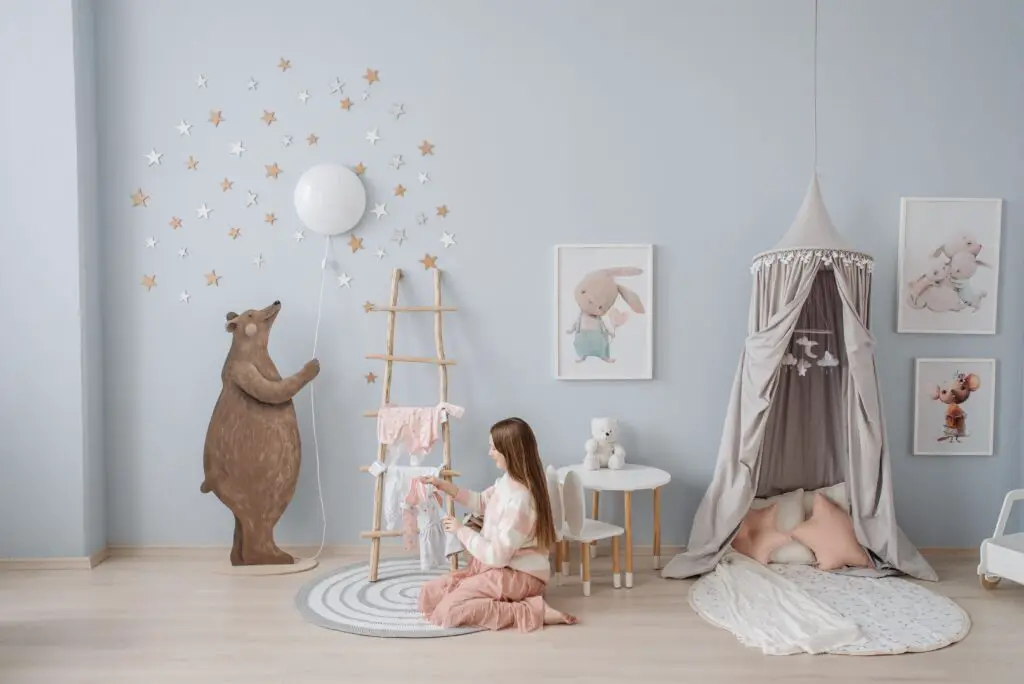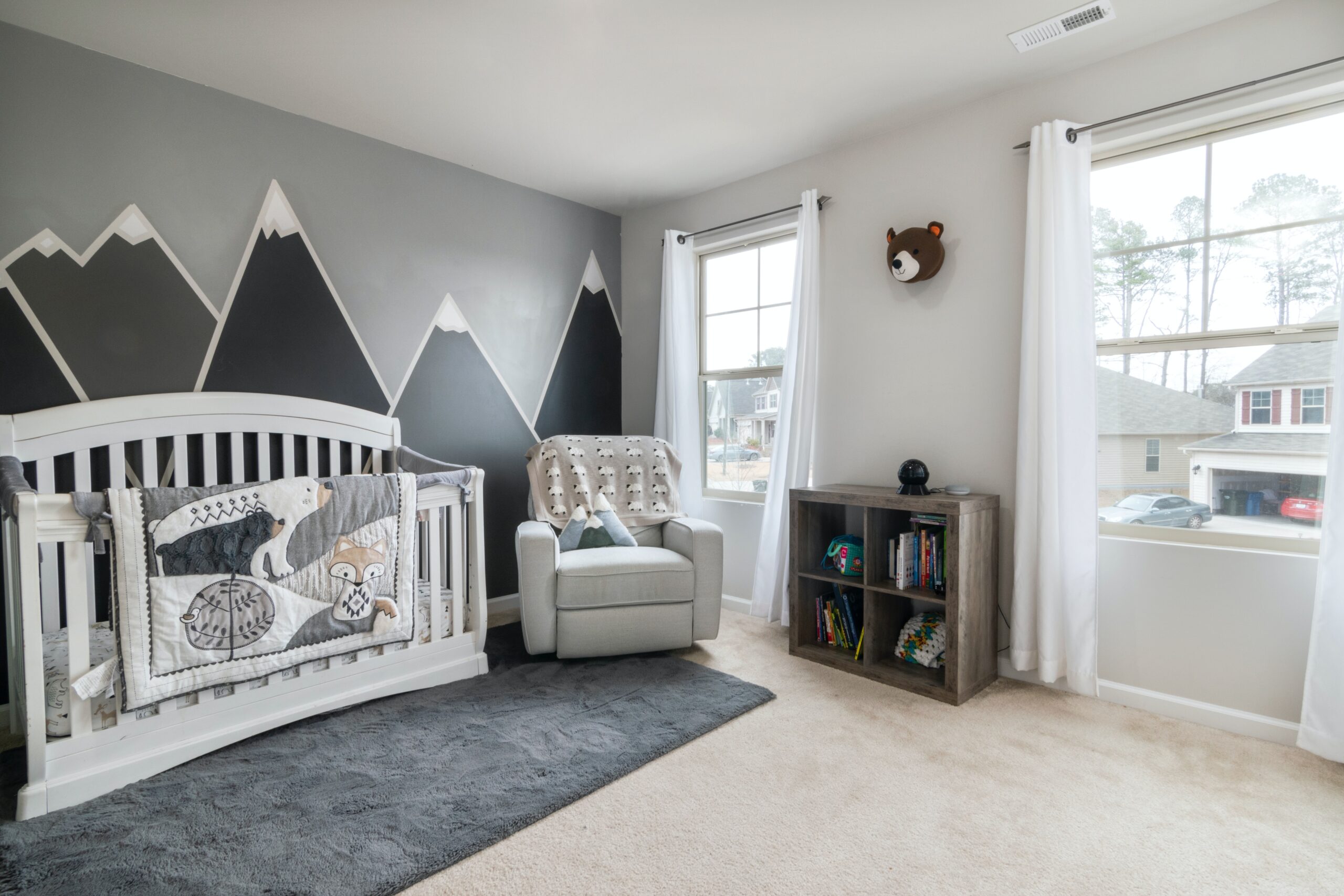Welcoming a new addition to your family is a joyous occasion, and one of the most exciting tasks is designing a nursery for your little bundle of joy. A well-designed baby room not only provides a cozy and safe environment for your baby to thrive but also becomes a cherished space filled with love and memories.
In this comprehensive guide, we will take you through the essential steps to create a cozy and practical nursery that suits your baby’s needs at every stage of their growth. From understanding the developmental requirements of your child to selecting the right furniture, colors, and decor, we have you covered.
I. Understanding the Needs of the Baby

Before diving into the design aspects, it’s crucial to understand the developmental needs of your baby. The design considerations for an infant’s nursery will differ from that of a toddler’s room. Safety is paramount at every stage, and you’ll need to take specific precautions to ensure a secure environment.
A. Age-appropriate design considerations
Infants (0-6 months)
During the first few months, babies need a calming and nurturing environment. Consider these design tips:
- Choose soft, soothing colors like pastels or neutrals.
- Opt for a crib with adjustable mattress height to accommodate your growing baby.
- Add blackout curtains to create a peaceful sleep environment.
Crawlers (6-12 months)
As your baby starts exploring the world around them, their nursery should encourage safe exploration:
- Use soft padding or area rugs to create a safe play area.
- Secure furniture to the walls to prevent tipping.
- Consider adding childproof locks to drawers and cabinets.
Toddlers (1-3 years)
Toddlers need a stimulating and organized space that fosters their creativity:
- Introduce more vibrant colors and interactive elements in the decor.
- Create a reading nook with age-appropriate books and seating.
- Provide low shelves and bins for easy toy access and cleanup.
B. Safety considerations
Creating a safe nursery is of utmost importance. Here are some safety measures to implement:
- Baby-proof electrical outlets and cords.
- Eliminate choking hazards and keep small objects out of reach.
- Use non-toxic and child-safe materials for furniture and decor.
II. Choosing the Right Location

The location of the nursery within your home can significantly impact your baby’s comfort and convenience. Factors like proximity to the parent’s bedroom, natural lighting, and noise insulation should be considered.
A. Proximity to parents’ bedroom
Having the nursery close to your bedroom facilitates nighttime feedings and check-ins without disrupting your rest. A separate room or a connected space with a door can offer the privacy you need while keeping your baby within easy reach.
B. Natural lighting and ventilation considerations
Natural light is beneficial for your baby’s circadian rhythm and overall well-being. Choose a room with ample windows and consider the direction of sunlight throughout the day. Proper ventilation is equally important for a fresh and healthy environment.
C. Noise insulation
Babies are sensitive to sounds, and a quiet nursery promotes better sleep. Consider soundproofing the nursery to minimize outside noises that may disturb your baby’s rest.
III. Designing the Layout

Creating a functional and organized layout is key to a practical nursery. Carefully plan the placement of furniture, play areas, and storage solutions.
A. Creating a functional floor plan
Placement of the crib
The crib should be the focal point of the nursery. Place it away from direct sunlight and drafts. Keep it within easy reach of your bed for nighttime feedings.
Arranging the changing station and storage areas
Position the changing table near the crib for easy access during diaper changes. Place storage units, such as dressers and wardrobes, close to the changing area for quick access to clothes and essentials.
Seating areas for parents
A comfortable seating area for parents is essential, especially for late-night feedings and storytimes. Consider a rocking chair or glider for soothing and bonding moments with your baby.
B. Traffic flow and accessibility
Ensure there is ample space to move around the nursery, especially if you have to navigate during nighttime visits. Keep the nursery clutter-free to ensure easy access to essential items.
IV. Selecting Cozy and Safe Furniture

The right furniture is not only essential for creating a cozy ambiance but also for ensuring your baby’s safety and comfort.
A. Choosing the right crib and mattress
Safety standards and certifications
When selecting a crib, ensure it meets safety standards and certifications, such as the ASTM International and Consumer Product Safety Commission (CPSC) guidelines.
Adjustable mattress heights
A crib with adjustable mattress heights allows you to lower the mattress as your baby grows and starts to stand, preventing climbing accidents.
B. Optimal furniture for storage and organization
Dressers and wardrobes
Choose sturdy and spacious dressers and wardrobes to organize your baby’s clothes, blankets, and essentials. Consider dressers with a changing top for added functionality.
Shelves and bookcases
Install shelves or bookcases to display and organize books, toys, and decorations. Make sure they are securely anchored to the wall to prevent tipping.
C. Rocking chair or glider for feeding and soothing
A comfortable and supportive rocking chair or glider is an invaluable addition to the nursery. It provides a cozy spot for feeding, soothing, and creating special bonding moments with your baby.
V. Color and Theme Selection

The color scheme and theme of the nursery play a significant role in setting the ambiance and mood of the space.
A. Calming and soothing color schemes
Choose soft and soothing colors like pastel shades of blue, pink, green, or neutral tones like beige or gray. These colors promote a sense of calm and tranquility, essential for a peaceful sleep environment.
B. Stimulating colors and patterns for older babies
For toddlers, you can introduce more vibrant colors and patterns to stimulate their imagination and curiosity. Consider using removable wall decals or murals that can be easily updated as your child’s interests evolve.
C. Theme ideas and how to incorporate them
Thematic nurseries are a popular choice for many parents. Whether you opt for a woodland, ocean, or space theme, ensure the decor is cohesive and age-appropriate. Use wall art, bedding, and accessories to bring the theme to life.
VI. Flooring and Rugs

Choosing the right flooring and rugs is essential for your baby’s safety, comfort, and playtime.
A. Baby-friendly flooring options
Soft carpeting
Carpeting provides a soft and comfortable surface for your baby to crawl and play. Choose carpets made from non-toxic and hypoallergenic materials.
Non-toxic hardwood or laminate
Hardwood or laminate flooring can be a practical and easy-to-clean option. Ensure the flooring is free from harmful chemicals, especially if your baby spends a lot of time on the floor.
B. Using rugs for warmth and comfort
Material and size considerations
Choose rugs made from natural fibers like cotton or wool, as they are gentle on your baby’s skin and are free from harmful chemicals. Select a rug size that covers the play and seating areas adequately.
Cleaning and maintenance tips
Opt for machine-washable or easy-to-clean rugs to maintain a hygienic and fresh nursery environment. Regularly vacuum and spot clean to remove dust and spills.
VII. Lighting Solutions

The right lighting can create a cozy and inviting atmosphere while providing functionality during nighttime activities.
A. General lighting for the nursery
Overhead fixtures
Install a soft and diffused overhead fixture to provide general illumination for the entire room. Use warm white or soft yellow bulbs to create a comforting ambiance.
Wall sconces or lamps
Add wall sconces or table lamps near the changing station and seating area for targeted lighting during specific activities.
B. Nighttime lighting for convenience
Dimmers or nightlights
Install dimmers on overhead lights or use nightlights to provide soft, low-level lighting during nighttime visits to the nursery. This minimizes disruptions to your baby’s sleep.
Avoiding harsh or stimulating lights during sleep
Avoid using bright or colorful nightlights that may interfere with your baby’s sleep patterns. Opt for warm, dim lighting instead.
VIII. Window Treatments

Window treatments not only enhance the nursery’s aesthetics but also serve practical purposes like light control and privacy.
A. Blackout curtains or blinds for better sleep
Blackout curtains or blinds are essential for creating a dark and serene sleep environment, especially during daytime naps or in areas with bright streetlights.
B. Cordless options for safety
Choose cordless window treatments to eliminate potential hazards and ensure your baby’s safety.
C. Decorative elements to enhance the room’s aesthetics
Use curtains or drapes that match the nursery’s theme and color scheme to add a touch of style and charm to the space.
IX. Personalizing the Space

Adding personalized touches to the nursery makes it extra special and meaningful for your baby and family.
A. Creating a gallery wall with baby’s pictures and art
Frame cherished photos, baby’s artwork, or inspirational prints to create a heartwarming gallery wall. This personalized display will remind you of the precious moments spent in the nursery.
B. Customizing decor with the baby’s name or initials
Incorporate your baby’s name or initials into decor elements like wall letters, blankets, or pillows to add a personal touch to the nursery.
C. Incorporating sentimental items and heirlooms
Display sentimental items, such as family heirlooms or keepsakes, that hold special significance to create a nursery filled with love and history.
X. Multi-functional Spaces

If you have limited space, creating a multi-functional nursery can be a practical solution.
A. Combining the nursery with a home office or guest room
Use a convertible crib that can transform into a daybed or toddler bed, allowing the room to evolve as your child grows. Consider a sofa bed or a daybed for guests.
B. Tips for maximizing space without compromising functionality
Use vertical space for storage by adding shelves or wall-mounted organizers. Choose furniture with built-in storage options to keep the nursery clutter-free.
XI. Maintaining a Clean and Organized Nursery

A clean and organized nursery promotes a peaceful and stress-free environment for both you and your baby.
A. Establishing a cleaning and organizing routine
Create a daily or weekly cleaning routine to keep the nursery tidy and hygienic. Involve family members in the cleanup to instill a sense of responsibility and teamwork.
B. Utilizing storage solutions to keep things tidy
Invest in baskets, bins, and storage boxes to keep toys, clothes, and baby essentials organized and easily accessible.
C. Regular decluttering and purging of unnecessary items
As your baby grows, you may accumulate more items than necessary. Regularly declutter the nursery to maintain a clean and clutter-free space.
XII. Budget-Friendly Nursery Ideas

Designing a beautiful and functional nursery doesn’t have to break the bank. Here are some budget-friendly tips:
A. DIY projects and upcycling furniture
Get creative and repurpose existing furniture or decor items for the nursery. Explore DIY projects for personalized touches without overspending.
B. Second-hand shopping for nursery items
Look for gently-used nursery items at consignment stores, online marketplaces, or garage sales. You can find quality items at a fraction of the cost.
C. Prioritizing essential purchases over luxury items
Focus on investing in essential items like a safe crib, a comfortable mattress, and storage solutions rather than splurging on unnecessary luxuries.
Conclusion
Designing a cozy and practical nursery for your baby is an exciting journey that allows you to create a safe and nurturing space where your child will grow and thrive. By understanding your baby’s developmental needs and implementing safety measures, you can design a space that promotes restful sleep, encourages exploration, and fosters a loving connection between you and your little one.
Remember to prioritize comfort, functionality, and personalization when choosing furniture, colors, and decor. Happy designing!
Frequently Asked Questions
1. How do you make a cozy baby room?
To create a cozy baby room, focus on soft and soothing colors, comfortable furniture, and soft lighting. Add soft textures like plush rugs, blankets, and cushions to make the space inviting and warm.
2. How do you set up a practical nursery?
A practical nursery requires careful planning and organization. Optimize the layout to ensure smooth traffic flow, and invest in functional furniture with ample storage, baby-proof the space to prioritize safety and ease of use.
3. How can you make a nursery more cozy?
You can make your nursery more cozy by adding elements like a rocking chair for cuddling, soft lighting for a calming ambiance, and wall art or decals to create a nurturing environment. Incorporate personal touches to make the room feel warm and inviting.
4. What to consider when designing a nursery?
When designing a nursery, consider the baby’s developmental needs, safety measures, and functional aspects like furniture placement and storage solutions. Additionally, think about the color scheme, theme, and personalization to make the nursery special and unique.



